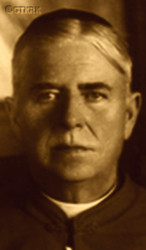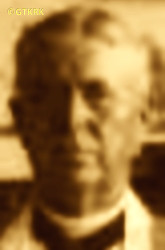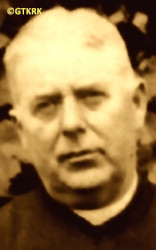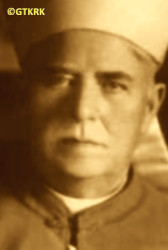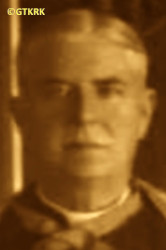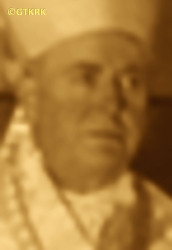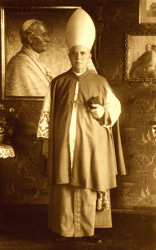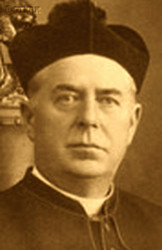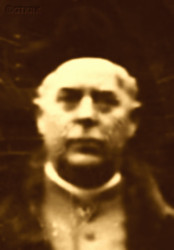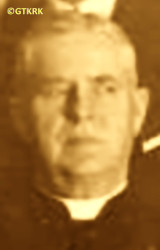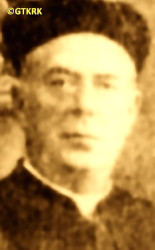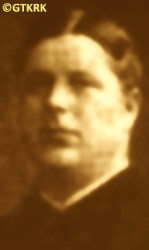Roman Catholic
St Sigismund parish
05-507 Słomczyn
85 Wiślana Str.
Konstancin deanery
Warsaw archdiocese, Poland
full list:
displayClick to display full list

searchClick to search full list by categories
wyświetlKliknij by wyświetlić pełną listę po polsku

szukajKliknij by przeszukać listę wg kategorii po polsku

Martyrology of the clergy — Poland
XX century (1914 – 1989)
personal data
surname
SZYDZIK
forename(s)
Joseph (pl. Józef)
function
diocesan priest
creed
Latin (Roman Catholic) Church RCmore on
en.wikipedia.org
[access: 2014.09.21]
diocese / province
Culm (Chełmno) diocesemore on
pl.wikipedia.org
[access: 2012.11.23]
honorary titles
protonotary apostolic (mitre) „in imitation” (ad instar)more on
en.wikipedia.org
[access: 2014.11.22]
(18.10.1936)
pontifical prelatemore on
en.wikipedia.org
[access: 2014.11.14]
(c. 1929)
Papal chamberlainmore on
en.wikipedia.org
[access: 2014.11.22]
(1927)
„Polonia Restituta” Cross — 5th Class, Knight'smore on
en.wikipedia.org
[access: 2019.04.16]
(11.11.1934)
„Medal of Independence”more on
en.wikipedia.org
[access: 2019.02.02]
(22.04.1938)
Badge of the Pomeranian Military Organization 1918‐1920
(c. 1929)
Silver „Cross of Merit”more on
en.wikipedia.org
[access: 2019.04.16]
(09.02.1925)
date and place
of death
29.09.1939

Bydgoszcztoday: Bydgoszcz city pov., Kuyavia‐Pomerania voiv., Poland
more on
en.wikipedia.org
[access: 2021.06.20]
alt. dates and places
of death
20.09.1939, 27.09.1939, 10‑11.1939
Fordontoday: district of Bydgoszcz, Bydgoszcz city pov., Kuyavia‐Pomerania voiv., Poland
more on
en.wikipedia.org
[access: 2021.09.02]
details of death
While studying at gymnasium in Brodnica — during Prussian times (partitions of Poland) — member (1886‐1891) and leader (1890‐1891) of the gymnasium chapter of a clandestine Polish self–education Karol Marcinkowski's Pomeranian Philomaths organization In 1918, after the abdication of the German Emperor Wilhelm II Hohenzollern on 09.11.1918, on the day of the armistice between the Allies and Germany signed on 11.11.1918 in the HQ train wagon of Marshal of France Ferdinand Foch in Compiègne — which de facto meant the end of World War I — Germans living in Chojnice founded the Workers' and Soldiers' Council, modeled on similar councils in Bolshevik Russia, which, of course, did not postulate the reconstruction of the Polish state. In response — after the Regency Council appointed few year earlier by the Central Powers (Germany and Austro–Hungary) and operating in the so‐called Germ. Königreich Polen (Eng. Kingdom of Poland), transferred the supreme authority over the army to Brigadier Joseph Piłsudski and appointed him commander‐in‐chief of the Polish army, which de facto meant the rebirth of the Polish state — became 15.11.1918 the chairman of the still acting clandestinely Polish Citizens' Committee in Chojnice.
On 02.12.1918, the Polish District People's Council was established openly in Chojnice — after the Polish People's Council was revealed on 11.11.1918 in Poznań, in the Prussian/German partition, renamed the Supreme People's Council three days later. On her behalf, became a delegate to the Polish District Seym in Poznań held on 03‐05.12.1918, where delegates from the lands of the Prussian/German partition, i.e. Greater Poland, Gdańsk Pomerania, Silesia and Warmia and Mazury, expressed, among others, the will to create a united Polish state with access to the sea.
On 11.12.1918, became the chairman of the County People's Council in Chojnice, and on 17.08.1919, a member of the liquidation commission established by it, the purpose of which was to eliminate the structures of German administration in the Chojnice county.
After the German attack on 01.09.1939 on the Republic of Poland (the Russians attacked Poland 17 days later) and the start of World War II, initially took shelter with several parishioners near Wałdów Królewski, c. 10 km from Fordon, on the other, eastern side of the Vistula. After the Germans occupied Fordon and the German occupation began, returned to his parish.
Arrested by the Germans on 20.09.1939.
Jailed in a transit camp in Bydgoszcz.
Was seen in the German Germ. Geheime Staatspolizei (Eng. Secret State Police), i.e. Gestapo offices and in IL Bromberg internment camp, with a white cross painted on the back.
Disappeared, probably murdered by a lethal injection.
In 1939, Bydgoszcz became a place of particular German repressions. Even before their invasion, the Germans on 03‐04.09.1939 organized a provocation in Bydgoszcz, during which Germ. Volksdeutsche (Eng. Ethnic Germans), i.e. representatives of the German minority in Poland, began shooting Polish soldiers defending Bydgoszcz in the back. The Poles suppressed the rebellion, prob. i.a. by executing many German traitors. The Germans exploited these events for propaganda purposes, calling them the Germ. „Bromberger Blutsonntag” (Eng. „Bydgoszcz Bloody Sunday”). After capturing the city on 05.09.1939, the Germans began bloody repressions against Poles. The Germ. Wehrmacht (Eng. Armed Forces), appointed by the Germ. 4. Armee (Eng. 4th Army), which captured Bydgoszcz, the commander of Bydgoszcz, Major General Walter Braemer, issued on 08.09.1939 an order, to cleanse the city of „criminal Polish elements”. The Germans began searching private homes, apartment by apartment. If weapons, e.g., souvenir sabres, etc., were found, the occupants were shot on the spot. Several public executions were also carried out.
The action was carried out by soldiers of the Germ. Wehrmacht and the genocidal Germ. Einsatzkommando 1/IV (Eng. 1/IV Task Group), part of the Germ. Einsatzgruppen (Eng. Operational Groups), a formation of the Germ. Sicherheitspolizei (Eng. Security Police), i.e. SiPo, and the Germ. Sicherheitsdienst des Reichsführers SS (Eng. Security Service of the Reichsführer SS), i.e. SD, subordinated to the Germ. Reichsicherheitshauptamt (Eng. Reich Main Security Office), i.e. RSHA, operating behind the German 4th Armee.
The repressions then turned into an organized extermination action — as part of the Germ. «Intelligenzaktion» (Eng. Intelligence Action), i.e. the extermination of the Polish intelligentsia and the leadership classes of Pomerania, based on the so‐called Germ. Sonderfahndungsliste (Eng. Special Wanted List), i.e. a proscription list of names of „enemies of the Reich”, prepared before the German aggression, or on some other proscription list, drawn up ad hoc on denunciations from local Germ. Volksdeutsche.
It was carried out by units of the genocidal Germ. Volksdeutscher Selbstschutz (Eng. Ethnic German Self‐Defense), whose members were Germ. Volksdeutsche from Bydgoszcz and the surrounding area, supervised by the paramilitary, genocidal Germ. Die Schutzstaffel der NSDAP (Eng. NSDAP Protection Unit), i.e. «SS», subordinate to the National Socialist German Workers' Party NSDAP, and supported by the Germ. Ordnungspolizei (Eng. Order Police), i.e. OrPo, a formation directly subordinated to the Germ. Chef der Deutschen Polizei (Eng. Chief of the German Police), the genocide master Heinrich Himmler. By the end of 1939, the Germans had murdered c. 5,000 Poles in public and hidden executions — many in nearby forests — including c. 1,500‐1,900 from Bydgoszcz alone.
Arrested Poles, after initial interrogations, were held mainly in the IL Bromberg internment camp, established on the premises of the barracks of the Polish 15th Light Artillery Regiment at 147 Gdańska Street. From there, were transported to the execution site or to concentration camps. In 09.1939 alone, c. 3,500 Poles (approximately 2.5% of Bydgoszcz's Polish residents) passed through the camp.
cause of death
murder
perpetrators
Germans
sites and events
FordonClick to display the description, TryszczynClick to display the description, IL BrombergClick to display the description, «Intelligenzaktion»Click to display the description, Reichsgau Danzig‐WestpreußenClick to display the description, Ribbentrop‐MolotovClick to display the description, Pius XI's encyclicalsClick to display the description, Thomas Zan SocietiesClick to display the description, Pomeranian PhilomathsClick to display the description
date and place
of birth
19.10.1871

Mikołajkitoday: Kurzętnik gm., Nowe Miasto Lubawskie pov., Warmia‐Masuria voiv., Poland
more on
en.wikipedia.org
[access: 2025.04.13]
alt. dates and places
of birth
18.10.1871
parents
SZYDZIK Francis
🞲 31.10.1833, Kamionkatoday: Kwidzyn gm., Kwidzyn pov., Pomerania voiv., Poland
more on
en.wikipedia.org
[access: 2025.08.19] — 🕆 18.07.1903, Nowe Miastotoday: Nowe Miasto gm., Płońsk pov., Masovia voiv., Poland
more on
en.wikipedia.org
[access: 2021.12.18]

ROSIŃSKA Anastasia
🞲 26.03.1846, Chełmnotoday: Chełmno urban gm., Chełmno pov., Kuyavia‐Pomerania voiv., Poland
more on
en.wikipedia.org
[access: 2021.07.25] — 🕆 1913, ?
presbyter (holy orders)
ordination
23.03.1896

Pelplintoday: Pelplin gm., Tczew pov., Pomerania voiv., Poland
more on
en.wikipedia.org
[access: 2021.05.06]
positions held
1938 – 1939
parish priest — Fordontoday: district of Bydgoszcz, Bydgoszcz city pov., Kuyavia‐Pomerania voiv., Poland
more on
en.wikipedia.org
[access: 2021.09.02] ⋄ St Nicholas the Bishop and Confessor RC parish ⋄ Fordontoday: district of Bydgoszcz, Bydgoszcz city pov., Kuyavia‐Pomerania voiv., Poland
more on
en.wikipedia.org
[access: 2021.09.02] RC deanery
till 1939
Bishop's delegate — Lubawa region, Bishop's Commissariat ⋄ Chełmno RC diocese
1926 – 1939
membership — Pelplintoday: Pelplin gm., Tczew pov., Pomerania voiv., Poland
more on
en.wikipedia.org
[access: 2021.05.06] ⋄ College of Consultors, Diocesan Curia
1929 – 1938
dean — Chełmżatoday: Chełmża urban gm., Toruń pov., Kuyavia‐Pomerania voiv., Poland
more on
en.wikipedia.org
[access: 2021.09.02] RC deanery
1924 – 1938
parish priest — Chełmżatoday: Chełmża urban gm., Toruń pov., Kuyavia‐Pomerania voiv., Poland
more on
en.wikipedia.org
[access: 2021.09.02] ⋄ Holy Trinity RC parish ⋄ Chełmżatoday: Chełmża urban gm., Toruń pov., Kuyavia‐Pomerania voiv., Poland
more on
en.wikipedia.org
[access: 2021.09.02] RC deanery
editor — Chełmżatoday: Chełmża urban gm., Toruń pov., Kuyavia‐Pomerania voiv., Poland
more on
en.wikipedia.org
[access: 2021.09.02] ⋄ „Church News”
chaplain — Chełmżatoday: Chełmża urban gm., Toruń pov., Kuyavia‐Pomerania voiv., Poland
more on
en.wikipedia.org
[access: 2021.09.02] ⋄ 1st Scout Team
president — Chełmżatoday: Chełmża urban gm., Toruń pov., Kuyavia‐Pomerania voiv., Poland
more on
en.wikipedia.org
[access: 2021.09.02] ⋄ branch, Polish Touring Society
president — Chełmżatoday: Chełmża urban gm., Toruń pov., Kuyavia‐Pomerania voiv., Poland
more on
en.wikipedia.org
[access: 2021.09.02] ⋄ People's Reading Rooms Society TCL
1905 – 1924
parish priest — Wieletoday: Korsin gm., Kościerzyna pov., Pomerania voiv., Poland
more on
en.wikipedia.org
[access: 2022.01.28] ⋄ St Nicholas the Bishop and Confessor RC parish ⋄ Tucholatoday: Tuchola gm., Tuchola pov., Kuyavia‐Pomerania voiv., Poland
more on
en.wikipedia.org
[access: 2021.09.02] RC deanery — the originator and builder of Wiele Calvary as well as the co–founder and director of the People's Bank in Wiele
1903 – 1905
parish priest — Ostródatoday: Ostróda urban gm., Ostróda pov., Warmia‐Masuria voiv., Poland
more on
en.wikipedia.org
[access: 2021.12.18] ⋄ Immaculate Conception of the Blessed Virgin Mary RC parish ⋄ Pomesaniadeanery name
today: Poland
more on
en.wikipedia.org
[access: 2020.11.27] RC deanery — also: prefect of gymnasium and lyceum, military chaplain in Prussian „Berg Barracks” and „Grollman Barracks”
curatus/rector/expositus — Chojnicetoday: Chojnice urban gm., Chojnice pov., Pomerania voiv., Poland
more on
en.wikipedia.org
[access: 2021.09.02] ⋄ Correctional House ⋄ Beheading of St John the Baptist RC parish ⋄ Człuchówtoday: Człuchów gm., Człuchów pov., Pomerania voiv., Poland
more on
en.wikipedia.org
[access: 2021.09.02] RC deanery
vicar — Chojnicetoday: Chojnice urban gm., Chojnice pov., Pomerania voiv., Poland
more on
en.wikipedia.org
[access: 2021.09.02] ⋄ Beheading of St John the Baptist RC parish ⋄ Człuchówtoday: Człuchów gm., Człuchów pov., Pomerania voiv., Poland
more on
en.wikipedia.org
[access: 2021.09.02] RC deanery
1897
vicar — Pączewotoday: Skórcz gm., Starogard Gdański pov., Pomerania voiv., Poland
more on
en.wikipedia.org
[access: 2022.01.28] ⋄ Annunciation to the Blessed Virgin Mary RC parish ⋄ Gniewtoday: Gniew gm., Tczew pov., Pomerania voiv., Poland
more on
en.wikipedia.org
[access: 2021.07.29] RC deanery
1896 – 1897
vicar — Oliwatoday: district in Gdańsk, Gdańsk city pov., Pomerania voiv., Poland
more on
en.wikipedia.org
[access: 2022.07.16] ⋄ Holy Trinity RC parish ⋄ Gdańsk IIdeanery name
today: Gdańsk city pov., Pomerania voiv., Poland
more on
en.wikipedia.org
[access: 2021.07.04] RC deanery
1891 – 1896
student — Pelplintoday: Pelplin gm., Tczew pov., Pomerania voiv., Poland
more on
en.wikipedia.org
[access: 2021.05.06] ⋄ philosophy and theology, Theological Seminary
1906 – 1939
membership — Toruńtoday: Toruń city pov., Kuyavia‐Pomerania voiv., Poland
more on
en.wikipedia.org
[access: 2021.06.20] ⋄ scientific society
Catholic journalist
others related
in death
JAKUBOWSKIClick to display biography John, ŁASKIClick to display biography Louis Eugene Vitus, SZAREKClick to display biography Peter, WIOREKClick to display biography Stanislav, RASZKOWSKIClick to display biography Hubert
sites and events
descriptions
Fordon: In the „Valley of Death” in Fordon, where from 10.10.1939 till 11.11.1939 Germans murdered — as a part of «Intelligenzaktion» aimed at extermination of Polish intelligentsia and ruling classes in Pomerania — 1,200‐3,000 Poles from Bydgoszcz, mainly from intelligentsia. (more on: pl.wikipedia.orgClick to attempt to display webpage
[access: 2012.11.23])
Tryszczyn: In the vicinity of Tryszczyn (10 km from Bydgoszcz) Germans — as a part of «Intelligenzaktion» aimed at extermination of Polish intelligentsia and ruling classes in Pomerania — murdered from 09.1939 till 10.1939 approx. 900 inhabitants of Bydgoszcz and surrounding villages. (more on: pl.wikipedia.orgClick to attempt to display webpage
[access: 2021.12.19])
IL Bromberg: Germ. „Internierungslager” (Eng. „Internment camp”) set up on 05.09.1939 — the day Germans took over Bydgoszcz — in 15 Greater Poland Light Artillery Regiment military barracks at 147 Gdańska Str. in Bydgoszcz. In 09.1939 only c. 3,500 Poles were jailed there. Prisoners were held in f. stables or f. armory building. They were maltreated and tortured. Some were shot on the spot (c. 28 victims in 09.1939). Next they were sent to concentration camps throughout Germany. Some were taken to mass execution sites in nearby forests and murdered. On 01.11.1939 the camp was moved to f. ammunition warehouses in Jachcice town district. The camp was closed in 12.1939. (more on: pl.wikipedia.orgClick to attempt to display webpage
[access: 2015.09.30])
«Intelligenzaktion»: German: «Intelligenzaktion» (English: „Intelligence Action”) — a German program of extermination of the Polish elite, mainly the intelligentsia and leadership layers, carried out from the beginning of the occupation in w 09.1939 to 04.1940, mainly in territories directly annexed to Germany, but also in the so‐called Germ. Generalgouvernement (Eng. General Governorate), where it was called «AB‐aktion». In the first phase, immediately after the beginning of the German occupation, during military operations carried out by the Germ. Wehrmacht (Eng. Armed Forces) and the genocidal units of the Germ. Einsatzgruppen (Eng. Operational Groups) of the Germ. Sicherheitspolizei (Eng. Security Police), i.e. SiPo, and Germ. Sicherheitsdienst des Reichsführers SS (Eng. Security Service of the Reichsführer SS), i.e. SD, organized by the Germ. Reichssicherheitshauptamt (Eng. Reich Main Security Office), i.e. RSHA, which followed the troops, carried out under the Germ. Unternehmen „Tannenberg” (Eng. Operation „Tannenberg”) — based on the so‐called Germ. Sonderfahndungsliste (Eng. Special Wanted Lists), i.e. proscription lists of Poles considered particularly dangerous to the Third Reich, prepared by the Zentralstelle II/P (Polen) unit of the German RSHA. Later, implemented by the German civilian occupation authorities and the genocidal unit of the Germ. Volksdeutscher Selbstschutz (Eng. Ethnic Germans Self‐Defense), whose members were Germ. Volksdeutsche (Eng. Ethnic Germans), i.e. representatives of the German minority in Poland. According to various sources, these lists, at the beginning of 09.1939, could have contained the details of 61,000—88,000 „dangerous” Poles — although these figures cannot be confirmed. In total, during this genocide, c. 50,000 teachers, Catholic priests, representatives of the landed gentry, freelancers, social and political activists, and retired military personnel were systematically and methodically murdered. Another 50,000 were sent to concentration camps, where only a negligible percentage survived. (more on: en.wikipedia.orgClick to attempt to display webpage
[access: 2014.10.04])
Reichsgau Danzig‐Westpreußen: After the Polish defeat in the 09.1939 campaign, which was the result of the Ribbentrop‐Molotov Pact and constituted the first stage of World War II, and the beginning of German occupation in part of Poland (in the other, eastern part of Poland, the Russian occupation began), the Germans divided the occupied Polish territory into five main regions (and a few smaller). The largest one was transformed into Germ. Generalgouvernement (Eng. General Governorate), intended exclusively for Poles and Jews and constituting part of the so‐called Germ. Großdeutschland (Eng. Greater Germany). Two were added to existing German provinces. From two other separate new provinces were created. Vistula Pomerania region was one of them, incorporated into Germany on 08.10.1939, by decree of the German leader Adolf Hitler (formally came into force on 26.10.1939), and on 02.11.1939 transformed into the Germ. Reichsgau Danzig‐Westpreußen (Eng. Reich District of Gdańsk‐West Prussia) province, in which the law of the German state was to apply. The main axis of the policy of the new province, the territory of which the Germans recognized as the Germ. „Ursprünglich Deutsche” (Eng. „natively German”), despite the fact that 85% of its inhabitants were Poles, was Germ. „Entpolonisierung” (Eng. „Depolonisation”), i.e. forced Germanization. C. 60,000 Poles were murdered in 1939‐1940, as part of the Germ. „Intelligenzaktion”, i.e. extermination of Polish intelligentsia and ruling classes, in c. 432 places of mass executions — including c. 220 Polish Catholic priests. The same number were sent to German concentration camps, from where few returned (over 300 priests were arrested, of whom c. 130 died in concentration camps). C. 124,000‐170,000 were displaced, including c. 90,000 to the Germ. Generalgouvernement. Poles were forced en masse to sign the German nationality list, the Germ. Deutsche Volksliste DVL. Polish children could only learn in German. It was forbidden to use the Polish language during Catholic Holy Masses and during confession. Polish landed estates were confiscated..To further reduce the number of the Polish population, Poles were sent to forced labor deep inside Germany. The remaining Poles were treated as low‐skilled labor, isolated from the Germans and strictly controlled — legally, three or three of them could only meet together, even in their own apartments. Many were conscripted into the German Wehrmacht army. After the end of hostilities of World War II, the overseer of this province, the Germ. Reichsstatthalter (Eng. Reich Governor) and the Germ. Gauleiter (Eng. district head) of the German National Socialist Party, Albert Maria Forster, was executed. (more on: en.wikipedia.orgClick to attempt to display webpage
[access: 2024.06.24])
Ribbentrop‐Molotov: Genocidal Russian‐German alliance pact between Russian leader Joseph Stalin and German leader Adolf Hitler signed on 23.08.1939 in Moscow by respective foreign ministers, Mr. Vyacheslav Molotov for Russia and Joachim von Ribbentrop for Germany. The pact sanctioned and was the direct cause of joint Russian and German invasion of Poland and the outbreak of the World War II in 09.1939. In a political sense, the pact was an attempt to restore the status quo ante before 1914, with one exception, namely the „commercial” exchange of the so‐called „Kingdom of Poland”, which in 1914 was part of the Russian Empire, fore Eastern Galicia (today's western Ukraine), in 1914 belonging to the Austro‐Hungarian Empire. Galicia, including Lviv, was to be taken over by the Russians, the „Kingdom of Poland” — under the name of the General Governorate — Germany. The resultant „war was one of the greatest calamities and dramas of humanity in history, for two atheistic and anti‐Christian ideologies — national and international socialism — rejected God and His fifth Decalogue commandment: Thou shall not kill!” (Abp Stanislav Gądecki, 01.09.2019). The decisions taken — backed up by the betrayal of the formal allies of Poland, France and Germany, which on 12.09.1939, at a joint conference in Abbeville, decided not to provide aid to attacked Poland and not to take military action against Germany (a clear breach of treaty obligations with Poland) — were on 28.09.1939 slightly altered and made more precise when a treaty on „German‐Russian boundaries and friendship” was agreed by the same murderous signatories. One of its findings was establishment of spheres of influence in Central and Eastern Europe and in consequence IV partition of Poland. In one of its secret annexes agreed, that: „the Signatories will not tolerate on its respective territories any Polish propaganda that affects the territory of the other Side. On their respective territories they will suppress all such propaganda and inform each other of the measures taken to accomplish it”. The agreements resulted in a series of meeting between two genocidal organization representing both sides — German Gestapo and Russian NKVD when coordination of efforts to exterminate Polish intelligentsia and Polish leading classes (in Germany called «Intelligenzaktion», in Russia took the form of Katyń massacres) where discussed. Resulted in deaths of hundreds of thousands of Polish intelligentsia, including thousands of priests presented here, and tens of millions of ordinary people,. The results of this Russian‐German pact lasted till 1989 and are still in evidence even today. (more on: en.wikipedia.orgClick to attempt to display webpage
[access: 2015.09.30])
Pius XI's encyclicals: Facing the creation of two totalitarian systems in Europe, which seemed to compete with each other, though there were more similarities than contradictions between them, Pope Pius XI issued in 03.1937 (within 5 days) two encyclicals. In the „Mit brennender Sorge” (Eng. „With Burning Concern”) published on 14.03.1938, condemned the national socialism prevailing in Germany. The Pope wrote: „Whoever, following the old Germanic‐pre‐Christian beliefs, puts various impersonal fate in the place of a personal God, denies the wisdom of God and Providence […], whoever exalts earthly values: race or nation, or state, or state system, representatives of state power or other fundamental values of human society, […] and makes them the highest standard of all values, including religious ones, and idolizes them, this one […] is far from true faith in God and from a worldview corresponding to such faith”. On 19.03.1937, published „Divini Redemptoris” (Eng. „Divine Redeemer”), in which criticized Russian communism, dialectical materialism and the class struggle theory. The Pope wrote: „Communism deprives man of freedom, and therefore the spiritual basis of all life norms. It deprives the human person of all his dignity and any moral support with which he could resist the onslaught of blind passions […] This is the new gospel that Bolshevik and godless communism preaches as a message of salvation and redemption of humanity”… Pius XI demanded that the established human law be subjected to the natural law of God , recommended the implementation of the ideal of a Christian state and society, and called on Catholics to resist. Two years later, National Socialist Germany and Communist Russia came together and started World War II. (more on: www.vatican.vaClick to attempt to display webpage
[access: 2023.05.28], www.vatican.vaClick to attempt to display webpage
[access: 2023.05.28])
Thomas Zan Societies: Secret societies of Polish youth, aiming at self‐education, patriotic in form and content, functioning 1830‐1920, in mutiny against enforced Germanisation and censure of Polish culture, mainly in secondary schools — gymnasia — mainly in Greater Poland (Wielkopolska) and later in Silesia. The first groups were formed in 1817. In 1897 a congress in Bydgoszcz was held when rules of clandestine activities were formulated. At other congress in Bydgoszcz in Poznań a „Red Rose” society was formed, heading all others groups in various gymnasiums and coordinating their activities. In 1900 „Red Rose” consolidated Philomaths organizations from Pomerania as well. After Toruń trial of Pomeranian Philomaths in Toruń Germans arrested 24 members of Thomas Zan Society from Gniezno. 21 of them were sentenced up to 6 weeks in prison and reprimands. All were relegated from schools without the right to continue education in secondary and higher schools in Prussia. Despite repression the Societies existed till 1918 and rebirth of Poland. (more on: pl.wikipedia.orgClick to attempt to display webpage
[access: 2021.12.19])
Pomeranian Philomaths: Secret societies of Polish youth, aiming at self‐education, patriotic in form and content, functioning 1830‐1920, mainly in secondary schools — gymnasia — in Pomerania around Vistula river (Gdańsk Pomerania and Chełmno county), in Prussian‐occupied Polish territories (one of the partitions of Poland). On 08.01.1901 Germans conducted a series of interrogations of students at Chełmno, Brodnica and Toruń gymnasiums. On 09‐12.09.1901 the first of court trials of Polish students from those gymnasiums and students of Theological Seminary in Pelplin was held in Toruń. 1 person was sentenced to 3 months in prison, 1 to 2 months, 3 to 6 weeks, 7 to 3 weeks, 2 to 2 weeks, 19 to a week, 2 to 1 day, 10 were reprimanded. 15 were cleared. More definitive penalties were relegations from the schools with so‐called wolf’s ticket, forbidding sentenced students to continue secondary and higher studies in Prussia (Germany). Among those penalized were a few future Catholic priests — those were able to continue their education for the Chełmno diocese bishop, Bp August Rosentreter, refused to relegate students from Theological Seminary. (more on: pl.wikipedia.orgClick to attempt to display webpage
[access: 2018.11.18])
sources
personal:
pl.wikipedia.orgClick to attempt to display webpage
[access: 2012.11.23], www.niedziela.plClick to attempt to display webpage
[access: 2012.12.28], www.mikolaj.bydgoszcz.plClick to attempt to display webpage
[access: 2015.09.30], www.kpbc.ukw.edu.plClick to attempt to display webpage
[access: 2014.10.04], czasopisma.ukw.edu.plClick to attempt to display webpage
[access: 2024.06.16], www.swzygmunt.knc.plClick to attempt to display webpage
[access: 2015.09.30]
bibliographical:
„Biographical dictionary of priests of the Chełmno diocese ordained in the years 1821‐1920”, Henry Mross, Pelplin, 1995
original images:
commons.wikimedia.orgClick to attempt to display webpage
[access: 2015.09.30], www.mikolaj.bydgoszcz.plClick to attempt to display webpage
[access: 2014.10.31], pliki.divart.plClick to attempt to display webpage
[access: 2018.11.18], www.mikolaj.bydgoszcz.plClick to attempt to display webpage
[access: 2014.10.31], www.mikolaj.bydgoszcz.plClick to attempt to display webpage
[access: 2014.10.31], libermortuorum.plClick to attempt to display webpage
[access: 2018.11.18], commons.wikimedia.orgClick to attempt to display webpage
[access: 2015.09.30], pl.wikipedia.orgClick to attempt to display webpage
[access: 2015.09.30], www.mikolaj.bydgoszcz.plClick to attempt to display webpage
[access: 2014.10.31], kpbc.umk.plClick to attempt to display webpage
[access: 2023.12.09]
LETTER to CUSTODIAN/ADMINISTRATOR
If you have an Email client on your communicator/computer — such as Mozilla Thunderbird, Windows Mail or Microsoft Outlook, described at WikipediaPatrz:
en.wikipedia.org, among others — try the link below, please:
LETTER to CUSTODIAN/ADMINISTRATORClick and try to call your own Email client
If however you do not run such a client or the above link is not active please send an email to the Custodian/Administrator using your account — in your customary email/correspondence engine — at the following address:

giving the following as the subject:
MARTYROLOGY: SZYDZIK Joseph
To return to the biography press below:
 Click to return to biography
Click to return to biography








